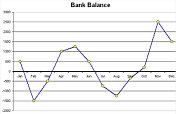Our previous article on the importance of cashflow accounting for business was written during Covid. It highlighted the benefits of financial forecasting to gauge cash requirements during the pandemic.
Now we are facing another crisis – the rising cost of living and an uncertain economic future. Whether it is filling up at the petrol station or buying our weekly groceries, higher prices are hitting every one of us and show no sign of slowing down.
All in all, these last couple of years have thrown up a number of unexpected challenges for businesses. Many have had to change their plans and adapt to continue trading. Many may now be looking for extra funding to cope with the disruption caused by the pandemic or the increase in running costs or simply to survive.
The government’s coronavirus grants schemes have all ended and while some measures are now being taken to ease the impact of rising inflation, these are set to benefit households rather than businesses.
 If you are a business owner, you will know how important it is to keep track of your income and outgoings. A cashflow forecast shows how much cash is expected to flow in and out of your business and is key to understanding where your business is right now.
If you are a business owner, you will know how important it is to keep track of your income and outgoings. A cashflow forecast shows how much cash is expected to flow in and out of your business and is key to understanding where your business is right now.
Creating a cashflow forecast can help you to better plan for the future and will provide you with the financial data to make more informed business decisions. It can help you control spending by identifying expected cash shortfalls and eliminate unnecessary expenses when cash is low. It can also point out potential problem areas before they become an issue and can predict any cash shortages.
You may find you have to raise your prices to meet the rising costs of things like energy, raw materials and wage bills. A cashflow forecast will let you understand your exact costs, so you know if you do need to increase your prices and by how much.
In the current economic climate, it can be hard to plan ahead but keeping your accounting records up to date is essential. Having timely and accurate data can help you keep a check on your cashflow and redirect money where it needs to go. You can then use ‘what if’ scenarios to forecast how resilient your business is to rising prices and the difficult months ahead.
If you use an accounting software package, such a Xero or QuickBooks Online, in your business these often have built-in budgeting options which allow you to build and track your cashflow projections and see your financial information. Now may not be the best time to invest in new technology but it is still worth considering the forecasting benefits it could provide for the future.